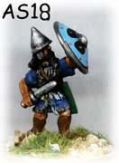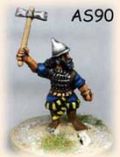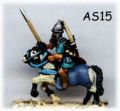Historical Overview Section
745-609BC
Before the military reforms of the former general / kingship-siezer Tiglath-Pileser III, the Middle or Neo-Assyrian army was very similar to the other Mesopotamian armies of the time. Soldiers were mostly raised farmers, who had to return to their fields to collect the harvest. Professional soldiers were limited to a few bodyguards that protected the King and or other nobles and officials. However this wasn't entirely successful as once the empire attempted to expand militarily, battle after battle killed off important soldiers, whilst the change of the seasons saw soldiers returning after a short time to their fields without achieving any really decisive conquests. But the upside was that the flowerbeds at the barracks were simply superb.
By the mid-eighth century B.C., the Assyrian levy-army could not cope with the demands of an empire that often stretched from the Mediterranean Sea to the Persian Gulf, and so when Tiglath Pileser III came to the throne in 745 B.C he changed the Assyrian army by the introduction of a standing army. This included a larger number of foreign soldiers supplied by vassal states as tribute or when demanded by the Assyrian King. They were given Assyrian equipment and uniform which made them indistinguishable from one another, possibly to increase their integration. Whilst the infantry in the standing army contained a large number of foreigners (including Aramaeans and even Greeks), the Assyrian Cavalry and Charioteers continued to be dominated by Assyrians. There were exceptions however, and as casualties mounted additional troops would not be unwelcome; Sargon II reports that he managed to incorporate 60 Israelite Chariot teams into his army.
The core of the Assyrian army lay in its chariots, originally used as two-horse vehicles. However, the rise of Cavalry in the 1st Millennia B.C. meant that by the 7th Century B.C. the Chariot was upgraded under the reign of Ashurnasirpal II to heavy four horse chariots which could contain more men and went off smashing into enemy formations and dispersing enemy infantry in the process. The Assyrian Cavalry and Infantry would then be able to exploit the gap and rout the enemy thereby taking the field!
The Assyrians were amongst the first to deploy charging cavalry under Tiglath Pileser III, and by the 7th century B.C., mounted Assyrian warriors were well armed with a bow and a lance, armored with lamellar armor and their mounts equipped with fabric armor, providing limited yet useful protection in close combat and against missiles. Cavalry would form the core of the later Assyrian armies. As the Empire suffered horrendous casualties under Ashurbanipal's campaigns of conquest, the rebellions following his death may have contributed significantly to the downfall of the Empire as fewer vassals were available to pay tribute horses and other war material needed.
Assyrian Infantry were cheaper and more numerous than the cavalry. Assyrian Infantry were composed of both native Assyrians and foreigners employed as auxiliaries, spearmen, slingers, shield bearers or archers. The latter type was the most dominant in Assyrian armies and from the time of Ashurnasirpal, archers would be accompanied by a shield bearer. Many different types of bows are recorded by the Assyrians, including Akkadian, Cimmerian and their own "Assyrian" type. Armour (lamellar) amongst the melee troops was limited to the best soldiers only, whilst the rest of the army made do with shields and helmets.
History
Tiglath-Pileser III attacked the army-list-less Babylonian Empire. After subjecting Babylon to tribute, severely punishing the Urartians, and defeating the Median and Neo-Hittite and Aramean polities, Tiglath-Pileser III directed his armies into Syro-Canaanite Syria and their Mediterranean Phoenician Allies. His successors took on the Philistines. The foremost successor, Sargon II waged war against the Neo-Elamitess, the Urartians and Syro-Canaanites and the the Median Empire. In 705 BC, Sargon was slain while fighting the Cimmerian or Early Skythian tribes, and was succeeded by his son Sennacherib who moved the capital to Nineveh. In 701 BC, Hezekiah of Judah formed an alliance with the New Kingdom Egyptians against Assyria, so Sennacherib accordingly marched toward Jerusalem, but failed to take it. He also fought the Neo-Elamites again.
This general pattern continued for ages, but the end result was the long struggles with Babylonia and Elam left Assyria maimed and exhausted. It had been drained of wealth and fighting population; the devastated provinces could yield nothing to supply the needs of the imperial exchequer, and it was difficult to find sufficient troops to garrison the conquered populations. Assyria, therefore, was ill-prepared to face the hordes of Scythians and Medes who now began to harass the frontiers to the east and ipon he death of the last decent ruler Ashurbanipal in 627 BC, the empire began to disintegrate rapidly. In 609 BC at the Battle of Megiddo, an Egyptian force defeated a Judean force and managed to reach the last remnants of the Assyrian army. In a final battle the newly formed Neo-Babylonian Empire forces crushed the Assyrian-Egyptian alliance, after which Assyria ceased to exist as an independent nation, poetically in much the same way that FoG had treated the Babylonians for the best part of the preceding thousand years.
Using the army in FoG
- With lots of shooting in this period, and lots of LF of your own to protect, an IC may be a good choice.
- Conversely, with limited numbers of strike troops, 2 TC's might suffice
- Guard Cav as elites are hyper-expensive, superiors can be better value, especially in 4-strong units
- The Chariots and HF can work together in open ground and will frighten most other in-period combos
- Like many armies in period, there are plenty of MF to occupy and shoot from terrain,
- Terrain hampers your chariots, but helps compress the battlefield for what is likely to end up as a small army overall.
- The Guard Cavalry can play a valuable role as rear support and as shooting skirmishers as well as their combat power
- The Guard infantry can rear-support other foot and may be avoided by the many MF in period - use them to shepherd your enemies
- Armoured foot shooters are rare in period, and look like a bit of a must-buy. Armour is equivalent to a weapon class in most combats they might enter into.
- Slingers offer cost effective shooting power, but even the MF can move up with the Chariots
- Strengths of the army: drilled, heavy shooting, good combined arms, ability to deal with terrain. Weaknesses: armoured Spearmen or Impact foot will give it trouble and it has no ideal counter-EL or counter-KN troops in open period.
- Terrain: Seek open room for chariots, and if the enemy lacks terrain strength, try for some central terrain we can control and shoot from - dividing the battle in two parts. Shooting lets us deal well with hills, otherwise we generally want to block placement so would try for open areas when placing second. Placing first, open is useful. Being drilled and liking the open, Impassable depressions or water are attractive. which work for us, but usually we deploy second so pick open areas if any left. LH and EL like Uneven, and Kn/Cats and Chariots are fragmented by Rough. Keep Chariots out of terrain!
UK Tournament Results with this army
Useful Links
User-contributed links about this army:
- Assyrian DBA Figure Gallery for this army - from Fanaticus
- Neo-Assyrian/Late Sargonid DBA Figure Gallery for this army - from Fanaticus
- Neo-Assyrians DBA Figure Gallery for this army - from Fanaticus
- Neo-Assyrians/Later Sargonids DBA Figure Gallery for this army - from Fanaticus
- Later Sargonids DBA Figure Gallery for this army - from Fanaticus
- Wikipedia on Sargon The wikipedia page
Allies
Put information on allied contingents here - including recommendations on which to use, and why.
Painting and Collecting the Army
- Paint schemes, insignia, shield designs? Put it here.
15mm Manufacturers supplying figures for this army
A listing of who supplies what can be found in my 15mm Suppliers directory. You can see some of the figures in the Ancients Photo Gallery also on this site

|

|

|

|
- Essex Miniatures - of course
- Old Glory Assyrian Range
- Magister Militum (includes former Chariot ranges)
- Museum
- Minifigs UK
- Lancashire Games
- Viking Forge
- Battle Line (NZ) former TTG Ranges
Army Lists
Sample army lists for this army
Richard Bodley-Scott's army that won Warfare 2009
- C-in-C TC - - - - - - CinC 1
- SG TC - - - - - - - 3
- 1 Tribal levies LF Unprotected Poor Undrilled Bow - - - 8
- 2 Tribal levies LF Unprotected Poor Undrilled Sling - - - 8
- 3 Mounted scouts LH Unprotected Average Drilled Bow - - - 4
- 4 Armoured spearmen HF Armoured Average Drilled - Light spear Swordsmen - 4
- 4 MF Armoured Average Drilled Bow - - - 4
- 5 Unarmoured spearmen HF Protected Average Drilled - Light spear Swordsmen - 4
- 5 MF Protected Average Drilled Bow - - - 4
- 6 Egyptian regiment MF Unprotected Average Drilled Bow - - - 4
- 7 Cavalry Cv Armoured Superior Drilled - Light spear Swordsmen - 2
- 7 Cv Armoured Superior Drilled Bow - Swordsmen - 2
- 8 Cavalry Cv Armoured Superior Drilled - Light spear Swordsmen - 2
- 8 Cv Armoured Superior Drilled Bow - Swordsmen - 2
- 9 Heavy chariots HCh - Superior Drilled Bow - - - 4
- 10 Unarmoured spearmen MF Protected Average Drilled - Light spear Swordsmen - 4
- 10 MF Protected Average Drilled Bow - - - 4
- 11 Unarmoured spearmen MF Protected Average Drilled - Light spear Swordsmen - 4
- 11 MF Protected Average Drilled Bow - - - 4
- 12 Heavy chariots HCh - Superior Drilled Bow - - - 4
Another 800 AP list
- IC - - - - - - - 1
- TC - - - - - - - 2
- Tribal Archers LF Unprotected Average Undrilled Bow - - - 6
- Tribal Levies - Slingers LF Unprotected Poor Undrilled Sling - - - 6
- Tribal Levies - Slingers LF Unprotected Poor Undrilled Sling - - - 6
- Mounted Scouts LH Unprotected Average Undrilled Bow - - - 4
- Unarmoured Spearmen MF Protected Average Drilled - Light Spear Swordsmen - 3
- — Supporting Archers MF Protected Average Drilled Bow - - - 3
- Armoured Spearmen HF Armoured Average Drilled - Light Spear Swordsmen - 3
- — Supporting Archers MF Armoured Average Drilled Bow - - - 3
- Armoured Spearmen HF Armoured Average Drilled - Light Spear Swordsmen - 3
- — Supporting Archers MF Armoured Average Drilled Bow - - - 3
- Chariots HCh - Superior Drilled Bow - - - 4
- Chariots HCh - Superior Drilled Bow - - - 4
- Guard Cavalry Cv Armoured Superior Drilled Bw* Light Spear Swordsmen - 4
- Guard Infantry HF Armoured Superior Drilled - Light Spear Swordsmen - 4
- Guard Infantry HF Armoured Superior Drilled - Light Spear Swordsmen - 4
- Unarmoured Spearmen MF Protected Average Drilled - Light Spear Swordsmen - 3
- — Supporting Archers MF Protected Average Drilled Bow - - - 3
- Delta Force (Egypt/Kushite) MF Unprotected Average Drilled Bow - - - 4
Q1:Skirmish start. Bow are intended to fight in aid of other shooters so go where there are likely targets. Slingers can skirmish non-shooty foot - advance in center to delay briefly and then fall back. The LH on the open wing most likely, or in the center if in doubt.
Q2: The large shields deploy together with a view to having rear support behind them later. Guards can do this in the rear, or on a flank. The first light BG goes to deal with obvious terrain - it can be supplemented later or not.
Q3: The Chariots and Cav can be brigaded all together for shock action, or Chariots split and the Cav with one or deployed as a feint and adjust later with one TC assigned.
Q4: Second Guard infantry deploys to reinforce the HF or support other troops. The other small shields deploy to join the first to sweep terrain or in rear support of the large shields or some other role favoring their mobility. The Delta Force is put either as rear support where it can deploy through the line or on a flank, with the chariots to help them shoot, or elsewhere to add dice. Against Chariots any terrain works well for them.
eBay Listings
UK Bookstore
